Teaching with Technology in Higher Education: A Longitudinal Study
VerifiedAdded on 2022/09/09
|18
|8826
|31
Report
AI Summary
This report presents a 10-year longitudinal study that investigated how teachers' conceptions of and approaches to teaching and learning with technology changed over time in a higher education setting. The study used a phenomenographic approach to analyze data from nine teachers at a Swedish university, revealing significant differences between novice and experienced teachers. Novice teachers demonstrated greater conceptual change, while experienced teachers showed little to no change. The research underscores the importance of supporting conceptual change through professional development to improve the effective use of educational technology in higher education. The findings suggest that a student-centered approach is essential for successful EdTech integration, and that teachers' conceptions of technology significantly impact their teaching practices. The study highlights the need for continuous professional development to ensure the effective and beneficial use of educational technology in higher education.
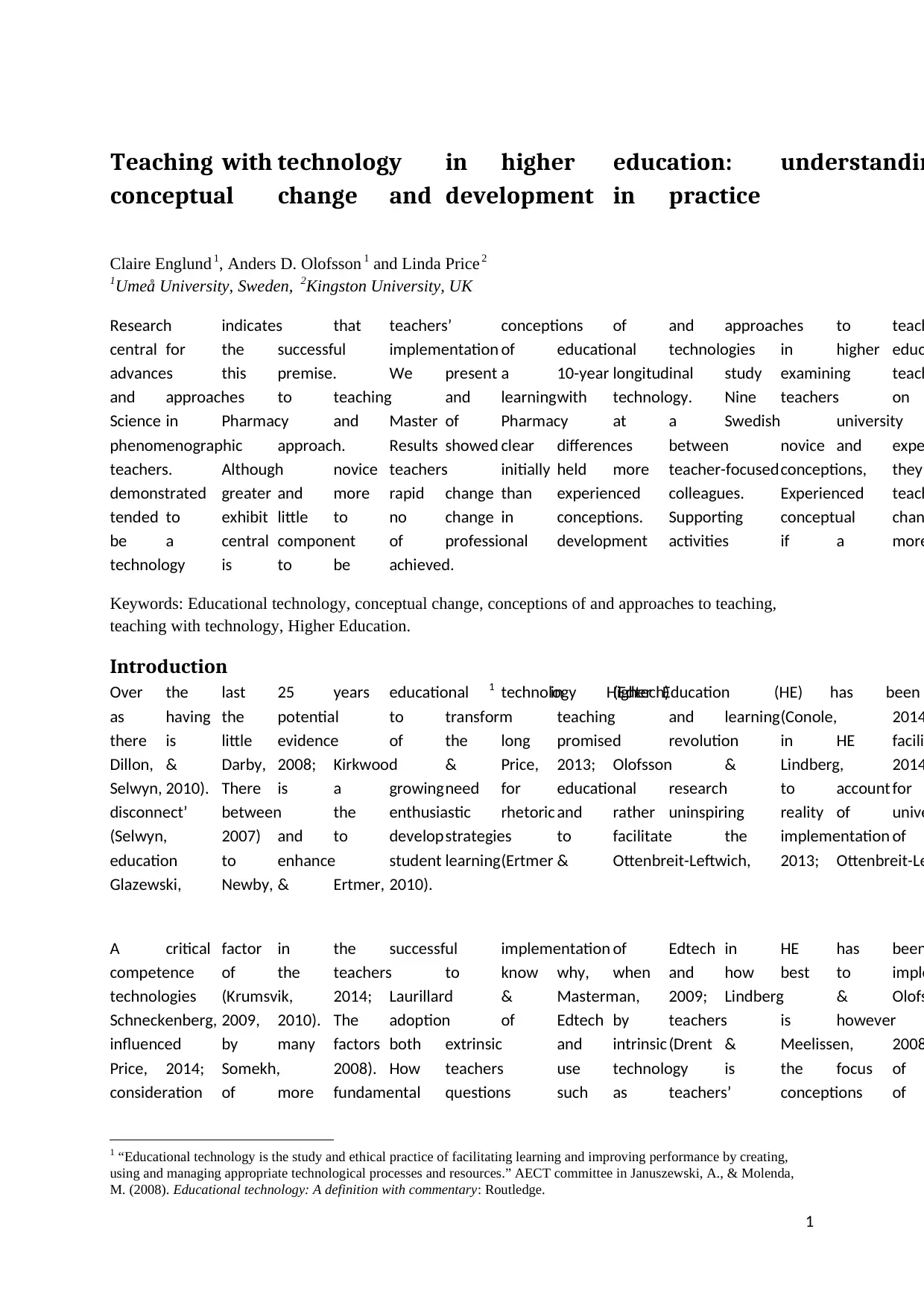
1
Teaching with technology in higher education: understandin
conceptual change and development in practice
Claire Englund 1, Anders D. Olofsson 1 and Linda Price 2
1Umeå University, Sweden, 2Kingston University, UK
Research indicates that teachers’ conceptions of and approaches to teach
central for the successful implementation of educational technologies in higher educ
advances this premise. We present a 10-year longitudinal study examining teach
and approaches to teaching and learningwith technology. Nine teachers on
Science in Pharmacy and Master of Pharmacy at a Swedish university
phenomenographic approach. Results showed clear differences between novice and expe
teachers. Although novice teachers initially held more teacher-focusedconceptions, they
demonstrated greater and more rapid change than experienced colleagues. Experienced teach
tended to exhibit little to no change in conceptions. Supporting conceptual chan
be a central component of professional development activities if a more
technology is to be achieved.
Keywords: Educational technology, conceptual change, conceptions of and approaches to teaching,
teaching with technology, Higher Education.
Introduction
Over the last 25 years educational technology (Edtech)1 in Higher Education (HE) has been
as having the potential to transform teaching and learning(Conole, 2014
there is little evidence of the long promised revolution in HE facili
Dillon, & Darby, 2008; Kirkwood & Price, 2013; Olofsson & Lindberg, 2014
Selwyn, 2010). There is a growingneed for educational research to account for
disconnect’ between the enthusiastic rhetoric and rather uninspiring reality of unive
(Selwyn, 2007) and to developstrategies to facilitate the implementation of
education to enhance student learning(Ertmer & Ottenbreit-Leftwich, 2013; Ottenbreit-Le
Glazewski, Newby, & Ertmer, 2010).
A critical factor in the successful implementation of Edtech in HE has been
competence of the teachers to know why, when and how best to imple
technologies (Krumsvik, 2014; Laurillard & Masterman, 2009; Lindberg & Olofs
Schneckenberg, 2009, 2010). The adoption of Edtech by teachers is however
influenced by many factors both extrinsic and intrinsic (Drent & Meelissen, 2008
Price, 2014; Somekh, 2008). How teachers use technology is the focus of
consideration of more fundamental questions such as teachers’ conceptions of
1 “Educational technology is the study and ethical practice of facilitating learning and improving performance by creating,
using and managing appropriate technological processes and resources.” AECT committee in Januszewski, A., & Molenda,
M. (2008). Educational technology: A definition with commentary: Routledge.
Teaching with technology in higher education: understandin
conceptual change and development in practice
Claire Englund 1, Anders D. Olofsson 1 and Linda Price 2
1Umeå University, Sweden, 2Kingston University, UK
Research indicates that teachers’ conceptions of and approaches to teach
central for the successful implementation of educational technologies in higher educ
advances this premise. We present a 10-year longitudinal study examining teach
and approaches to teaching and learningwith technology. Nine teachers on
Science in Pharmacy and Master of Pharmacy at a Swedish university
phenomenographic approach. Results showed clear differences between novice and expe
teachers. Although novice teachers initially held more teacher-focusedconceptions, they
demonstrated greater and more rapid change than experienced colleagues. Experienced teach
tended to exhibit little to no change in conceptions. Supporting conceptual chan
be a central component of professional development activities if a more
technology is to be achieved.
Keywords: Educational technology, conceptual change, conceptions of and approaches to teaching,
teaching with technology, Higher Education.
Introduction
Over the last 25 years educational technology (Edtech)1 in Higher Education (HE) has been
as having the potential to transform teaching and learning(Conole, 2014
there is little evidence of the long promised revolution in HE facili
Dillon, & Darby, 2008; Kirkwood & Price, 2013; Olofsson & Lindberg, 2014
Selwyn, 2010). There is a growingneed for educational research to account for
disconnect’ between the enthusiastic rhetoric and rather uninspiring reality of unive
(Selwyn, 2007) and to developstrategies to facilitate the implementation of
education to enhance student learning(Ertmer & Ottenbreit-Leftwich, 2013; Ottenbreit-Le
Glazewski, Newby, & Ertmer, 2010).
A critical factor in the successful implementation of Edtech in HE has been
competence of the teachers to know why, when and how best to imple
technologies (Krumsvik, 2014; Laurillard & Masterman, 2009; Lindberg & Olofs
Schneckenberg, 2009, 2010). The adoption of Edtech by teachers is however
influenced by many factors both extrinsic and intrinsic (Drent & Meelissen, 2008
Price, 2014; Somekh, 2008). How teachers use technology is the focus of
consideration of more fundamental questions such as teachers’ conceptions of
1 “Educational technology is the study and ethical practice of facilitating learning and improving performance by creating,
using and managing appropriate technological processes and resources.” AECT committee in Januszewski, A., & Molenda,
M. (2008). Educational technology: A definition with commentary: Routledge.
Paraphrase This Document
Need a fresh take? Get an instant paraphrase of this document with our AI Paraphraser
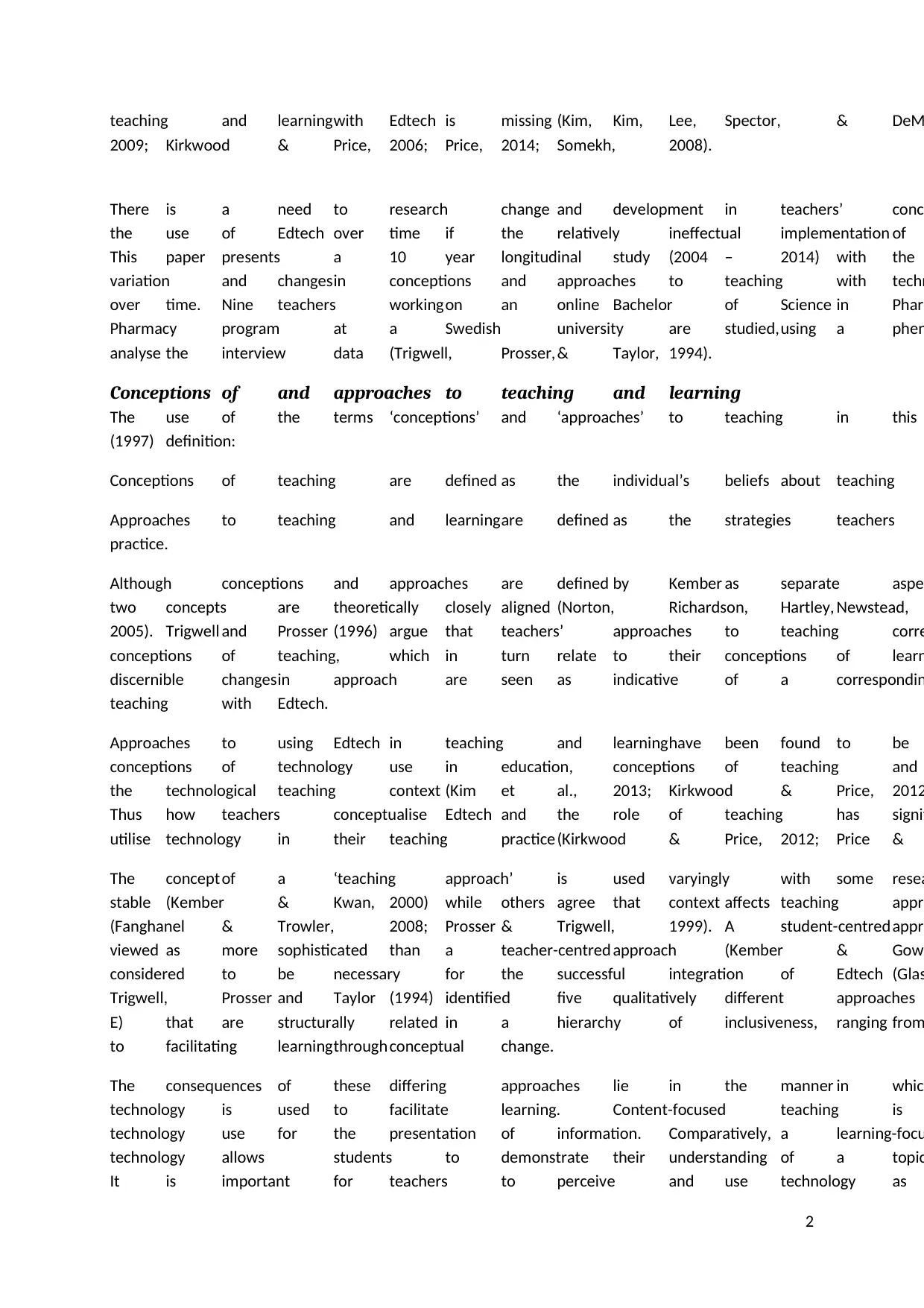
2
teaching and learningwith Edtech is missing (Kim, Kim, Lee, Spector, & DeM
2009; Kirkwood & Price, 2006; Price, 2014; Somekh, 2008).
There is a need to research change and development in teachers’ conc
the use of Edtech over time if the relatively ineffectual implementation of
This paper presents a 10 year longitudinal study (2004 – 2014) with the
variation and changesin conceptions and approaches to teaching with techn
over time. Nine teachers workingon an online Bachelor of Science in Pharm
Pharmacy program at a Swedish university are studied,using a phen
analyse the interview data (Trigwell, Prosser,& Taylor, 1994).
Conceptions of and approaches to teaching and learning
The use of the terms ‘conceptions’ and ‘approaches’ to teaching in this
(1997) definition:
Conceptions of teaching are defined as the individual’s beliefs about teaching
Approaches to teaching and learningare defined as the strategies teachers
practice.
Although conceptions and approaches are defined by Kember as separate aspe
two concepts are theoretically closely aligned (Norton, Richardson, Hartley, Newstead,
2005). Trigwell and Prosser (1996) argue that teachers’ approaches to teaching corre
conceptions of teaching, which in turn relate to their conceptions of learn
discernible changesin approach are seen as indicative of a correspondin
teaching with Edtech.
Approaches to using Edtech in teaching and learninghave been found to be
conceptions of technology use in education, conceptions of teaching and
the technological teaching context (Kim et al., 2013; Kirkwood & Price, 2012
Thus how teachers conceptualise Edtech and the role of teaching has signifi
utilise technology in their teaching practice(Kirkwood & Price, 2012; Price &
The conceptof a ‘teaching approach’ is used varyingly with some resea
stable (Kember & Kwan, 2000) while others agree that context affects teaching appro
(Fanghanel & Trowler, 2008; Prosser & Trigwell, 1999). A student-centredappro
viewed as more sophisticated than a teacher-centred approach (Kember & Gow,
considered to be necessary for the successful integration of Edtech (Glas
Trigwell, Prosser and Taylor (1994) identified five qualitatively different approaches
E) that are structurally related in a hierarchy of inclusiveness, ranging from
to facilitating learningthroughconceptual change.
The consequences of these differing approaches lie in the manner in whic
technology is used to facilitate learning. Content-focused teaching is
technology use for the presentation of information. Comparatively, a learning-focu
technology allows students to demonstrate their understanding of a topic
It is important for teachers to perceive and use technology as
teaching and learningwith Edtech is missing (Kim, Kim, Lee, Spector, & DeM
2009; Kirkwood & Price, 2006; Price, 2014; Somekh, 2008).
There is a need to research change and development in teachers’ conc
the use of Edtech over time if the relatively ineffectual implementation of
This paper presents a 10 year longitudinal study (2004 – 2014) with the
variation and changesin conceptions and approaches to teaching with techn
over time. Nine teachers workingon an online Bachelor of Science in Pharm
Pharmacy program at a Swedish university are studied,using a phen
analyse the interview data (Trigwell, Prosser,& Taylor, 1994).
Conceptions of and approaches to teaching and learning
The use of the terms ‘conceptions’ and ‘approaches’ to teaching in this
(1997) definition:
Conceptions of teaching are defined as the individual’s beliefs about teaching
Approaches to teaching and learningare defined as the strategies teachers
practice.
Although conceptions and approaches are defined by Kember as separate aspe
two concepts are theoretically closely aligned (Norton, Richardson, Hartley, Newstead,
2005). Trigwell and Prosser (1996) argue that teachers’ approaches to teaching corre
conceptions of teaching, which in turn relate to their conceptions of learn
discernible changesin approach are seen as indicative of a correspondin
teaching with Edtech.
Approaches to using Edtech in teaching and learninghave been found to be
conceptions of technology use in education, conceptions of teaching and
the technological teaching context (Kim et al., 2013; Kirkwood & Price, 2012
Thus how teachers conceptualise Edtech and the role of teaching has signifi
utilise technology in their teaching practice(Kirkwood & Price, 2012; Price &
The conceptof a ‘teaching approach’ is used varyingly with some resea
stable (Kember & Kwan, 2000) while others agree that context affects teaching appro
(Fanghanel & Trowler, 2008; Prosser & Trigwell, 1999). A student-centredappro
viewed as more sophisticated than a teacher-centred approach (Kember & Gow,
considered to be necessary for the successful integration of Edtech (Glas
Trigwell, Prosser and Taylor (1994) identified five qualitatively different approaches
E) that are structurally related in a hierarchy of inclusiveness, ranging from
to facilitating learningthroughconceptual change.
The consequences of these differing approaches lie in the manner in whic
technology is used to facilitate learning. Content-focused teaching is
technology use for the presentation of information. Comparatively, a learning-focu
technology allows students to demonstrate their understanding of a topic
It is important for teachers to perceive and use technology as
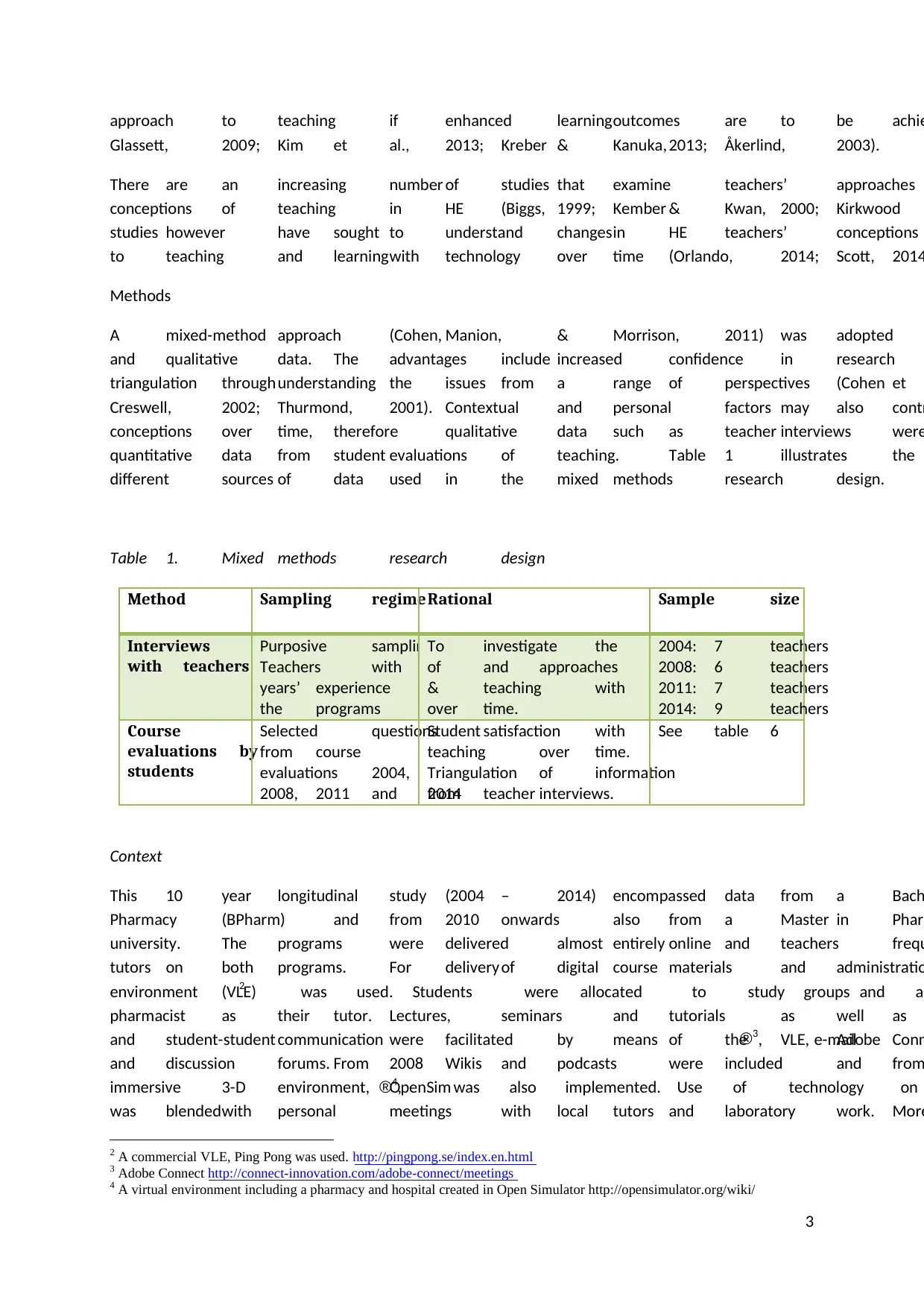
3
approach to teaching if enhanced learningoutcomes are to be achie
Glassett, 2009; Kim et al., 2013; Kreber & Kanuka, 2013; Åkerlind, 2003).
There are an increasing number of studies that examine teachers’ approaches
conceptions of teaching in HE (Biggs, 1999; Kember & Kwan, 2000; Kirkwood
studies however have sought to understand changesin HE teachers’ conceptions
to teaching and learningwith technology over time (Orlando, 2014; Scott, 2014
Methods
A mixed-method approach (Cohen, Manion, & Morrison, 2011) was adopted
and qualitative data. The advantages include increased confidence in research
triangulation throughunderstanding the issues from a range of perspectives (Cohen et
Creswell, 2002; Thurmond, 2001). Contextual and personal factors may also contr
conceptions over time, therefore qualitative data such as teacher interviews were
quantitative data from student evaluations of teaching. Table 1 illustrates the
different sources of data used in the mixed methods research design.
Table 1. Mixed methods research design
Method Sampling regimeRational Sample size
Interviews
with teachers
Purposive sampling.
Teachers with 10
years’ experience of
the programs
To investigate the conceptions
of and approaches to teaching
& teaching with technology
over time.
2004: 7 teachers
2008: 6 teachers
2011: 7 teachers
2014: 9 teachers
Course
evaluations by
students
Selected questions
from course
evaluations 2004,
2008, 2011 and 2014
Student satisfaction with
teaching over time.
Triangulation of information
from teacher interviews.
See table 6
Context
This 10 year longitudinal study (2004 – 2014) encompassed data from a Bach
Pharmacy (BPharm) and from 2010 onwards also from a Master in Pharm
university. The programs were delivered almost entirely online and teachers frequ
tutors on both programs. For deliveryof digital course materials and administratio
environment (VLE)2 was used. Students were allocated to study groups and as
pharmacist as their tutor. Lectures, seminars and tutorials as well as
and student-student communication were facilitated by means of the VLE, Adobe Conn®3, e-mail
and discussion forums. From 2008 Wikis and podcasts were included and from
immersive 3-D environment, OpenSim®4, was also implemented. Use of technology on
was blendedwith personal meetings with local tutors and laboratory work. More
2 A commercial VLE, Ping Pong was used. http://pingpong.se/index.en.html
3 Adobe Connect http://connect-innovation.com/adobe-connect/meetings
4 A virtual environment including a pharmacy and hospital created in Open Simulator http://opensimulator.org/wiki/
approach to teaching if enhanced learningoutcomes are to be achie
Glassett, 2009; Kim et al., 2013; Kreber & Kanuka, 2013; Åkerlind, 2003).
There are an increasing number of studies that examine teachers’ approaches
conceptions of teaching in HE (Biggs, 1999; Kember & Kwan, 2000; Kirkwood
studies however have sought to understand changesin HE teachers’ conceptions
to teaching and learningwith technology over time (Orlando, 2014; Scott, 2014
Methods
A mixed-method approach (Cohen, Manion, & Morrison, 2011) was adopted
and qualitative data. The advantages include increased confidence in research
triangulation throughunderstanding the issues from a range of perspectives (Cohen et
Creswell, 2002; Thurmond, 2001). Contextual and personal factors may also contr
conceptions over time, therefore qualitative data such as teacher interviews were
quantitative data from student evaluations of teaching. Table 1 illustrates the
different sources of data used in the mixed methods research design.
Table 1. Mixed methods research design
Method Sampling regimeRational Sample size
Interviews
with teachers
Purposive sampling.
Teachers with 10
years’ experience of
the programs
To investigate the conceptions
of and approaches to teaching
& teaching with technology
over time.
2004: 7 teachers
2008: 6 teachers
2011: 7 teachers
2014: 9 teachers
Course
evaluations by
students
Selected questions
from course
evaluations 2004,
2008, 2011 and 2014
Student satisfaction with
teaching over time.
Triangulation of information
from teacher interviews.
See table 6
Context
This 10 year longitudinal study (2004 – 2014) encompassed data from a Bach
Pharmacy (BPharm) and from 2010 onwards also from a Master in Pharm
university. The programs were delivered almost entirely online and teachers frequ
tutors on both programs. For deliveryof digital course materials and administratio
environment (VLE)2 was used. Students were allocated to study groups and as
pharmacist as their tutor. Lectures, seminars and tutorials as well as
and student-student communication were facilitated by means of the VLE, Adobe Conn®3, e-mail
and discussion forums. From 2008 Wikis and podcasts were included and from
immersive 3-D environment, OpenSim®4, was also implemented. Use of technology on
was blendedwith personal meetings with local tutors and laboratory work. More
2 A commercial VLE, Ping Pong was used. http://pingpong.se/index.en.html
3 Adobe Connect http://connect-innovation.com/adobe-connect/meetings
4 A virtual environment including a pharmacy and hospital created in Open Simulator http://opensimulator.org/wiki/
⊘ This is a preview!⊘
Do you want full access?
Subscribe today to unlock all pages.

Trusted by 1+ million students worldwide
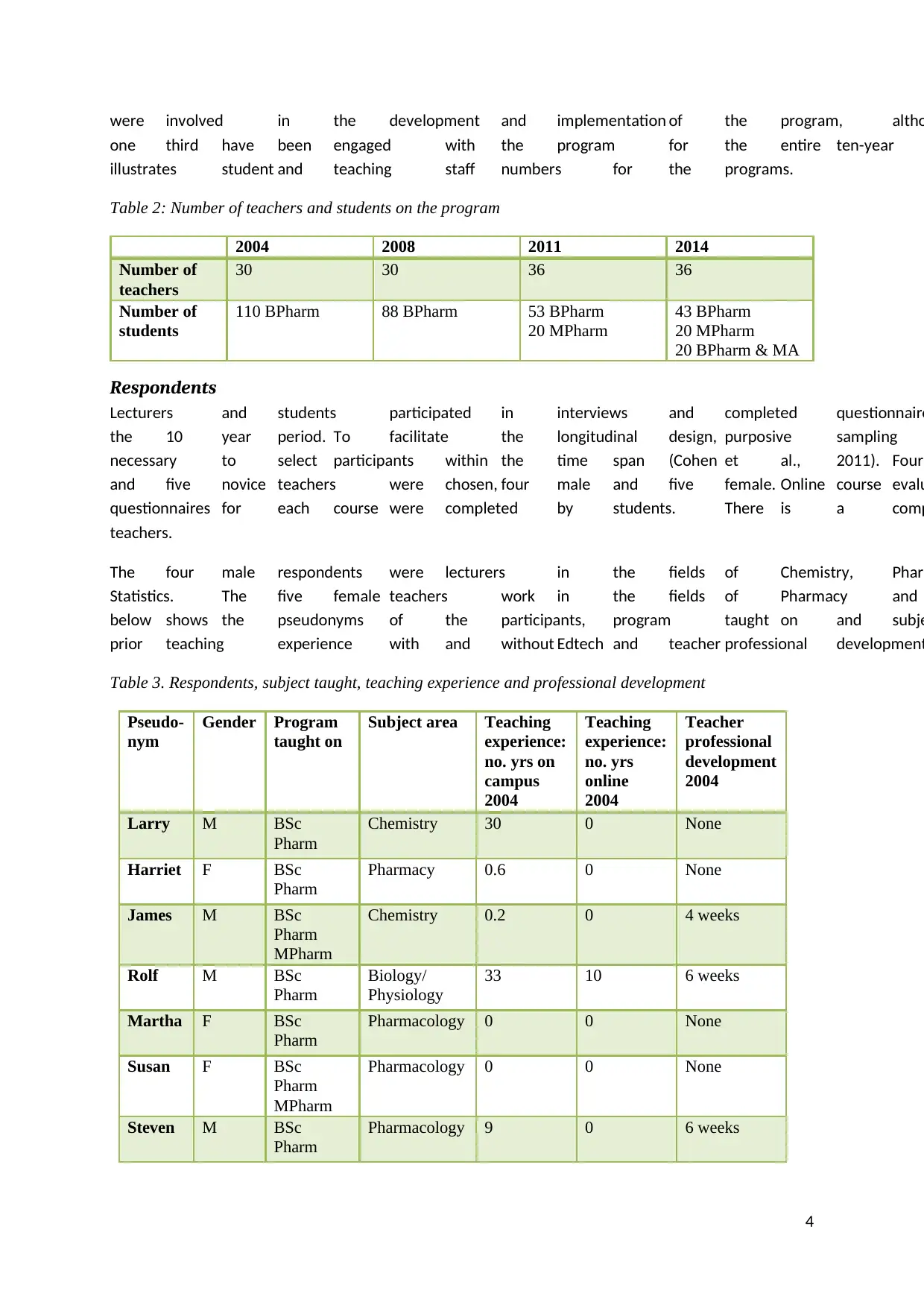
4
were involved in the development and implementation of the program, altho
one third have been engaged with the program for the entire ten-year
illustrates student and teaching staff numbers for the programs.
Table 2: Number of teachers and students on the program
2004 2008 2011 2014
Number of
teachers
30 30 36 36
Number of
students
110 BPharm 88 BPharm 53 BPharm
20 MPharm
43 BPharm
20 MPharm
20 BPharm & MA
Respondents
Lecturers and students participated in interviews and completed questionnaire
the 10 year period. To facilitate the longitudinal design, purposive sampling
necessary to select participants within the time span (Cohen et al., 2011). Four
and five novice teachers were chosen, four male and five female. Online course evalu
questionnaires for each course were completed by students. There is a comp
teachers.
The four male respondents were lecturers in the fields of Chemistry, Pharm
Statistics. The five female teachers work in the fields of Pharmacy and
below shows the pseudonyms of the participants, program taught on and subje
prior teaching experience with and without Edtech and teacher professional development
Table 3. Respondents, subject taught, teaching experience and professional development
Pseudo-
nym
Gender Program
taught on
Subject area Teaching
experience:
no. yrs on
campus
2004
Teaching
experience:
no. yrs
online
2004
Teacher
professional
development
2004
Larry M BSc
Pharm
Chemistry 30 0 None
Harriet F BSc
Pharm
Pharmacy 0.6 0 None
James M BSc
Pharm
MPharm
Chemistry 0.2 0 4 weeks
Rolf M BSc
Pharm
Biology/
Physiology
33 10 6 weeks
Martha F BSc
Pharm
Pharmacology 0 0 None
Susan F BSc
Pharm
MPharm
Pharmacology 0 0 None
Steven M BSc
Pharm
Pharmacology 9 0 6 weeks
were involved in the development and implementation of the program, altho
one third have been engaged with the program for the entire ten-year
illustrates student and teaching staff numbers for the programs.
Table 2: Number of teachers and students on the program
2004 2008 2011 2014
Number of
teachers
30 30 36 36
Number of
students
110 BPharm 88 BPharm 53 BPharm
20 MPharm
43 BPharm
20 MPharm
20 BPharm & MA
Respondents
Lecturers and students participated in interviews and completed questionnaire
the 10 year period. To facilitate the longitudinal design, purposive sampling
necessary to select participants within the time span (Cohen et al., 2011). Four
and five novice teachers were chosen, four male and five female. Online course evalu
questionnaires for each course were completed by students. There is a comp
teachers.
The four male respondents were lecturers in the fields of Chemistry, Pharm
Statistics. The five female teachers work in the fields of Pharmacy and
below shows the pseudonyms of the participants, program taught on and subje
prior teaching experience with and without Edtech and teacher professional development
Table 3. Respondents, subject taught, teaching experience and professional development
Pseudo-
nym
Gender Program
taught on
Subject area Teaching
experience:
no. yrs on
campus
2004
Teaching
experience:
no. yrs
online
2004
Teacher
professional
development
2004
Larry M BSc
Pharm
Chemistry 30 0 None
Harriet F BSc
Pharm
Pharmacy 0.6 0 None
James M BSc
Pharm
MPharm
Chemistry 0.2 0 4 weeks
Rolf M BSc
Pharm
Biology/
Physiology
33 10 6 weeks
Martha F BSc
Pharm
Pharmacology 0 0 None
Susan F BSc
Pharm
MPharm
Pharmacology 0 0 None
Steven M BSc
Pharm
Pharmacology 9 0 6 weeks
Paraphrase This Document
Need a fresh take? Get an instant paraphrase of this document with our AI Paraphraser
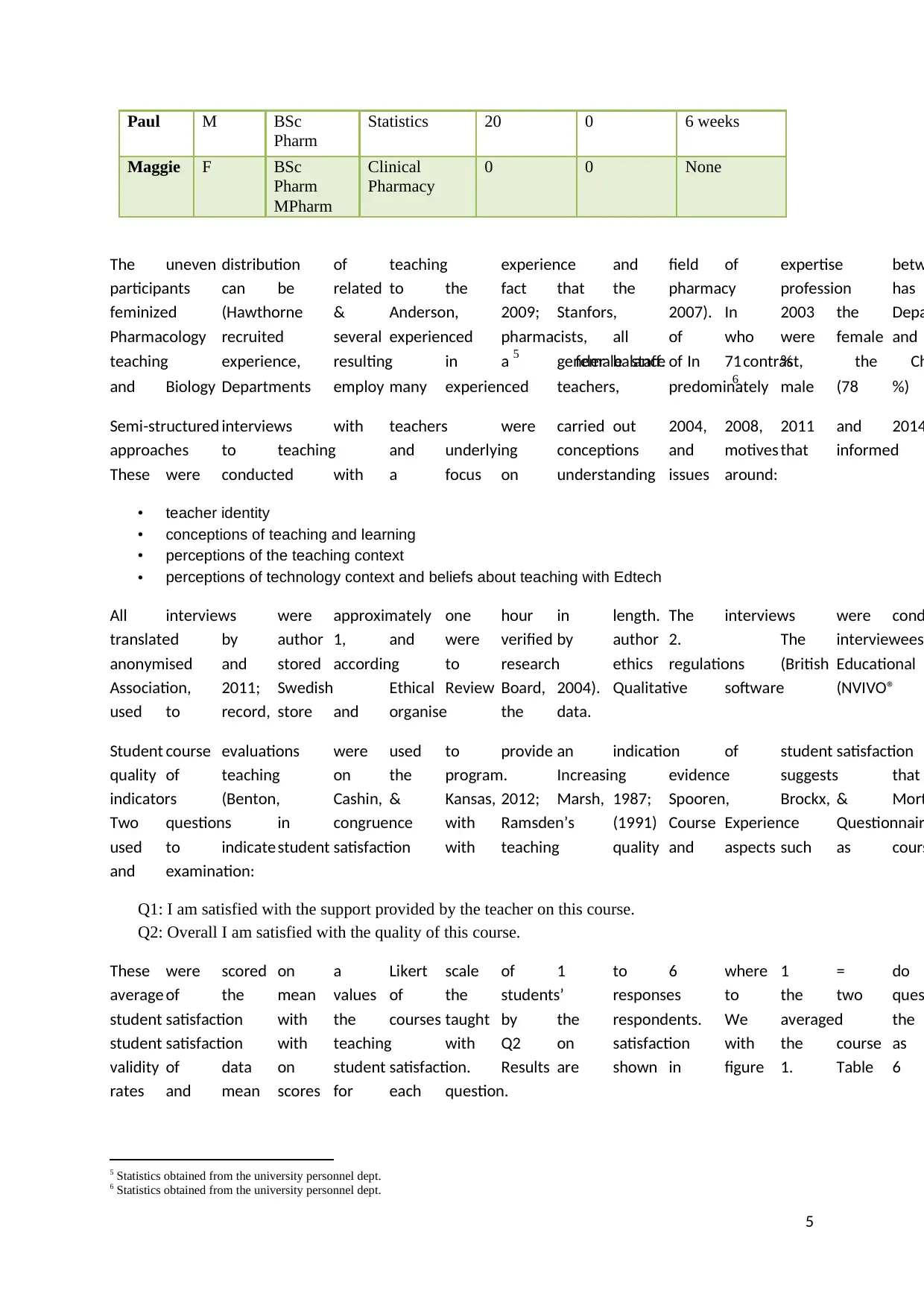
5
Paul M BSc
Pharm
Statistics 20 0 6 weeks
Maggie F BSc
Pharm
MPharm
Clinical
Pharmacy
0 0 None
The uneven distribution of teaching experience and field of expertise betw
participants can be related to the fact that the pharmacy profession has
feminized (Hawthorne & Anderson, 2009; Stanfors, 2007). In 2003 the Depa
Pharmacology recruited several experienced pharmacists, all of who were female and
teaching experience, resulting in a gender balance of 71 %
5 female staff. In contrast, the Ch
and Biology Departments employ many experienced teachers, predominately male (78 %)
6.
Semi-structured interviews with teachers were carried out 2004, 2008, 2011 and 2014
approaches to teaching and underlying conceptions and motives that informed
These were conducted with a focus on understanding issues around:
• teacher identity
• conceptions of teaching and learning
• perceptions of the teaching context
• perceptions of technology context and beliefs about teaching with Edtech
All interviews were approximately one hour in length. The interviews were cond
translated by author 1, and were verified by author 2. The interviewees
anonymised and stored according to research ethics regulations (British Educational
Association, 2011; Swedish Ethical Review Board, 2004). Qualitative software (NVIVO®
used to record, store and organise the data.
Student course evaluations were used to provide an indication of student satisfaction
quality of teaching on the program. Increasing evidence suggests that
indicators (Benton, Cashin, & Kansas, 2012; Marsh, 1987; Spooren, Brockx, & Mort
Two questions in congruence with Ramsden’s (1991) Course Experience Questionnair
used to indicatestudent satisfaction with teaching quality and aspects such as cours
and examination:
Q1: I am satisfied with the support provided by the teacher on this course.
Q2: Overall I am satisfied with the quality of this course.
These were scored on a Likert scale of 1 to 6 where 1 = do
average of the mean values of the students’ responses to the two ques
student satisfaction with the courses taught by the respondents. We averaged the
student satisfaction with teaching with Q2 on satisfaction with the course as
validity of data on student satisfaction. Results are shown in figure 1. Table 6
rates and mean scores for each question.
5 Statistics obtained from the university personnel dept.
6 Statistics obtained from the university personnel dept.
Paul M BSc
Pharm
Statistics 20 0 6 weeks
Maggie F BSc
Pharm
MPharm
Clinical
Pharmacy
0 0 None
The uneven distribution of teaching experience and field of expertise betw
participants can be related to the fact that the pharmacy profession has
feminized (Hawthorne & Anderson, 2009; Stanfors, 2007). In 2003 the Depa
Pharmacology recruited several experienced pharmacists, all of who were female and
teaching experience, resulting in a gender balance of 71 %
5 female staff. In contrast, the Ch
and Biology Departments employ many experienced teachers, predominately male (78 %)
6.
Semi-structured interviews with teachers were carried out 2004, 2008, 2011 and 2014
approaches to teaching and underlying conceptions and motives that informed
These were conducted with a focus on understanding issues around:
• teacher identity
• conceptions of teaching and learning
• perceptions of the teaching context
• perceptions of technology context and beliefs about teaching with Edtech
All interviews were approximately one hour in length. The interviews were cond
translated by author 1, and were verified by author 2. The interviewees
anonymised and stored according to research ethics regulations (British Educational
Association, 2011; Swedish Ethical Review Board, 2004). Qualitative software (NVIVO®
used to record, store and organise the data.
Student course evaluations were used to provide an indication of student satisfaction
quality of teaching on the program. Increasing evidence suggests that
indicators (Benton, Cashin, & Kansas, 2012; Marsh, 1987; Spooren, Brockx, & Mort
Two questions in congruence with Ramsden’s (1991) Course Experience Questionnair
used to indicatestudent satisfaction with teaching quality and aspects such as cours
and examination:
Q1: I am satisfied with the support provided by the teacher on this course.
Q2: Overall I am satisfied with the quality of this course.
These were scored on a Likert scale of 1 to 6 where 1 = do
average of the mean values of the students’ responses to the two ques
student satisfaction with the courses taught by the respondents. We averaged the
student satisfaction with teaching with Q2 on satisfaction with the course as
validity of data on student satisfaction. Results are shown in figure 1. Table 6
rates and mean scores for each question.
5 Statistics obtained from the university personnel dept.
6 Statistics obtained from the university personnel dept.
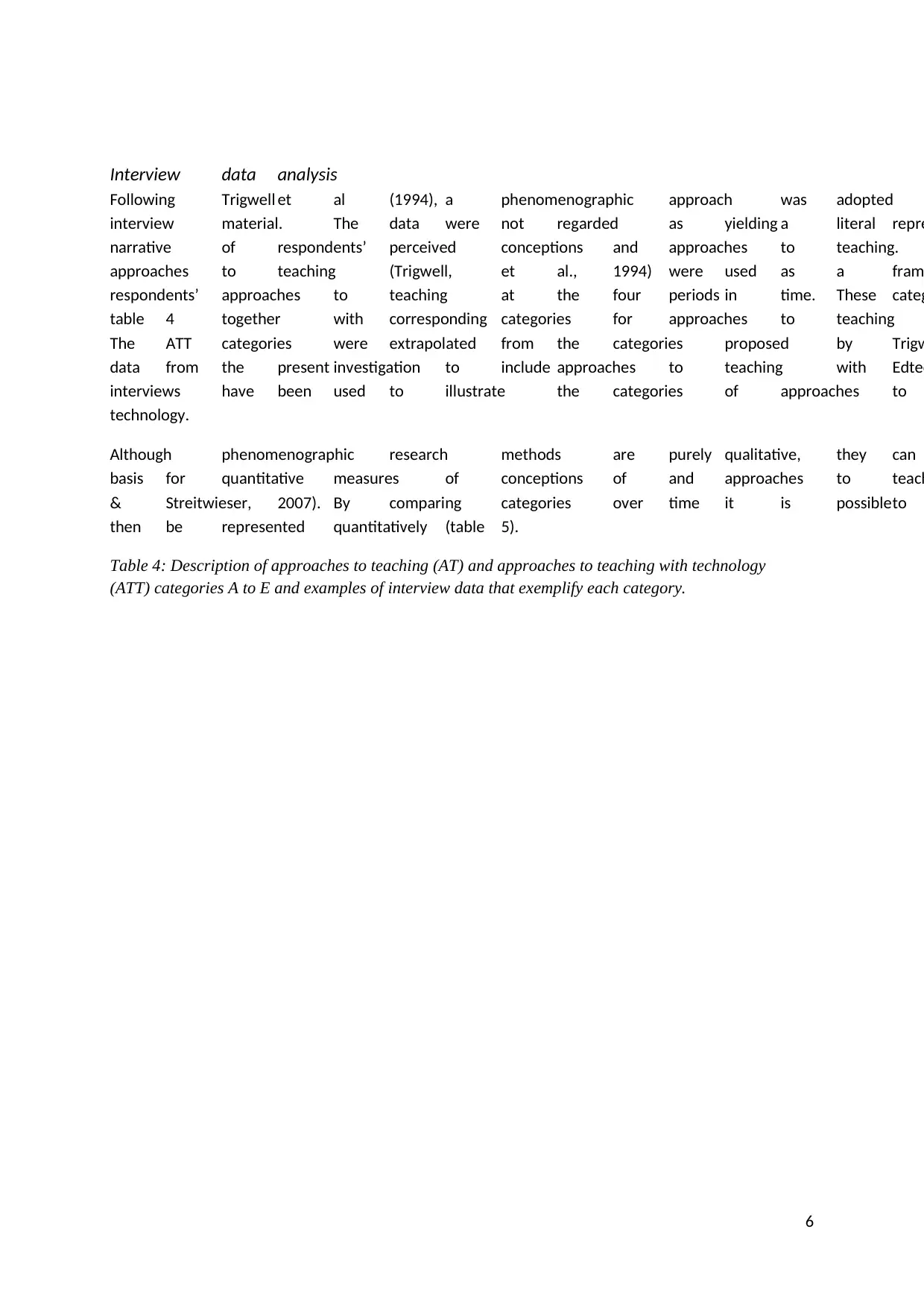
6
Interview data analysis
Following Trigwell et al (1994), a phenomenographic approach was adopted
interview material. The data were not regarded as yielding a literal repre
narrative of respondents’ perceived conceptions and approaches to teaching.
approaches to teaching (Trigwell, et al., 1994) were used as a fram
respondents’ approaches to teaching at the four periods in time. These categ
table 4 together with corresponding categories for approaches to teaching
The ATT categories were extrapolated from the categories proposed by Trigw
data from the present investigation to include approaches to teaching with Edtec
interviews have been used to illustrate the categories of approaches to
technology.
Although phenomenographic research methods are purely qualitative, they can
basis for quantitative measures of conceptions of and approaches to teach
& Streitwieser, 2007). By comparing categories over time it is possibleto
then be represented quantitatively (table 5).
Table 4: Description of approaches to teaching (AT) and approaches to teaching with technology
(ATT) categories A to E and examples of interview data that exemplify each category.
Interview data analysis
Following Trigwell et al (1994), a phenomenographic approach was adopted
interview material. The data were not regarded as yielding a literal repre
narrative of respondents’ perceived conceptions and approaches to teaching.
approaches to teaching (Trigwell, et al., 1994) were used as a fram
respondents’ approaches to teaching at the four periods in time. These categ
table 4 together with corresponding categories for approaches to teaching
The ATT categories were extrapolated from the categories proposed by Trigw
data from the present investigation to include approaches to teaching with Edtec
interviews have been used to illustrate the categories of approaches to
technology.
Although phenomenographic research methods are purely qualitative, they can
basis for quantitative measures of conceptions of and approaches to teach
& Streitwieser, 2007). By comparing categories over time it is possibleto
then be represented quantitatively (table 5).
Table 4: Description of approaches to teaching (AT) and approaches to teaching with technology
(ATT) categories A to E and examples of interview data that exemplify each category.
⊘ This is a preview!⊘
Do you want full access?
Subscribe today to unlock all pages.

Trusted by 1+ million students worldwide

Approaches to teaching and learning, (AT) Approaches to teaching and learning wi
(ATT)
Approach
A:
Teacher-focused activity with the intention of
transferring information to the students. The focus is
on transmitting discipline-based facts and skills, but
not on the relationships between them. No prior
knowledge by students is assumed or that students
need to be active in the learning process.
Activity is teacher-focused where technology i
information about the discipline. No interaction
anticipated. Of importance is the demonstration
discipline-based facts and skills using technolo
tool.
Example
quotes:
Quite honestly I think that it’s the student’s role to
listen and mine to talk, whether it’s lectures or any
other form of activity.
Instead of standing and giving the same lecture
and years, if you record the lecture the student
like.
Approach
B:
Teacher-focused activities with the intention of
helping students acquire the main concepts and the
relationships between them. Students don’t need to be
active in the learning process. Students’ understanding
of the subject matter is built through working within
the predetermined teacher and/or content framework
structures.
The focus of activity remains on the teacher di
based information. Different delivery strategies
understand the material. The teacher uses techn
acquire the concepts of the syllabus. Students’
subject matter is facilitated through working w
content materials delivered via institutional tec
Example
quotes:
It’s important that the students are with you, that you
don’t leave them behind but test the waters now and
then to see if everyone has understood, or if you need
to back up a bit, take something again or if you can
continue.
I’ve created an animation, a tabletting machin
limited time in the course I hope that this simu
their understanding of what happens when the
into a tablet and that it is quite complex.
(ATT)
Approach
A:
Teacher-focused activity with the intention of
transferring information to the students. The focus is
on transmitting discipline-based facts and skills, but
not on the relationships between them. No prior
knowledge by students is assumed or that students
need to be active in the learning process.
Activity is teacher-focused where technology i
information about the discipline. No interaction
anticipated. Of importance is the demonstration
discipline-based facts and skills using technolo
tool.
Example
quotes:
Quite honestly I think that it’s the student’s role to
listen and mine to talk, whether it’s lectures or any
other form of activity.
Instead of standing and giving the same lecture
and years, if you record the lecture the student
like.
Approach
B:
Teacher-focused activities with the intention of
helping students acquire the main concepts and the
relationships between them. Students don’t need to be
active in the learning process. Students’ understanding
of the subject matter is built through working within
the predetermined teacher and/or content framework
structures.
The focus of activity remains on the teacher di
based information. Different delivery strategies
understand the material. The teacher uses techn
acquire the concepts of the syllabus. Students’
subject matter is facilitated through working w
content materials delivered via institutional tec
Example
quotes:
It’s important that the students are with you, that you
don’t leave them behind but test the waters now and
then to see if everyone has understood, or if you need
to back up a bit, take something again or if you can
continue.
I’ve created an animation, a tabletting machin
limited time in the course I hope that this simu
their understanding of what happens when the
into a tablet and that it is quite complex.
Paraphrase This Document
Need a fresh take? Get an instant paraphrase of this document with our AI Paraphraser
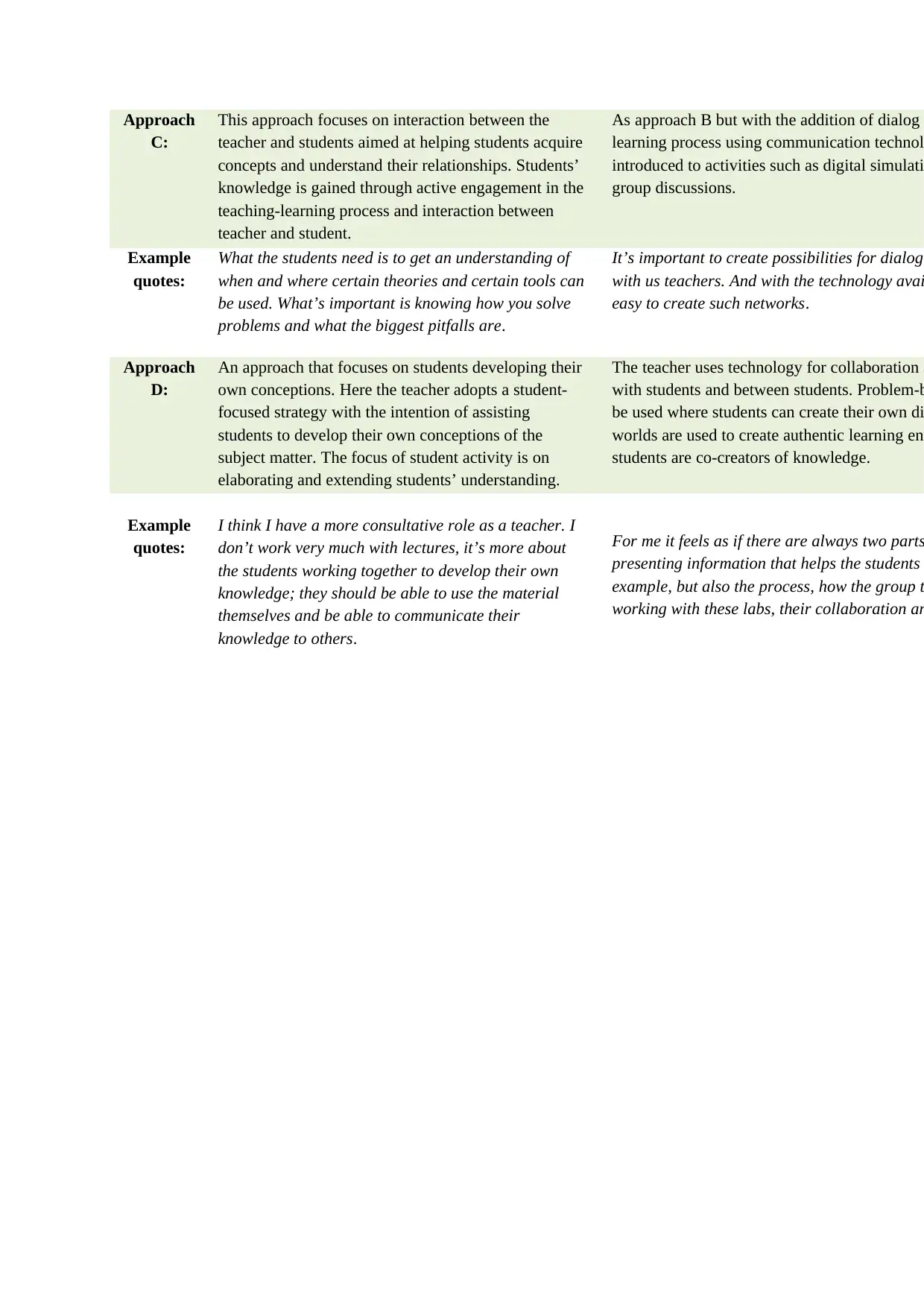
Approach
C:
This approach focuses on interaction between the
teacher and students aimed at helping students acquire
concepts and understand their relationships. Students’
knowledge is gained through active engagement in the
teaching-learning process and interaction between
teacher and student.
As approach B but with the addition of dialog
learning process using communication technol
introduced to activities such as digital simulati
group discussions.
Example
quotes:
What the students need is to get an understanding of
when and where certain theories and certain tools can
be used. What’s important is knowing how you solve
problems and what the biggest pitfalls are.
It’s important to create possibilities for dialog
with us teachers. And with the technology avai
easy to create such networks.
Approach
D:
An approach that focuses on students developing their
own conceptions. Here the teacher adopts a student-
focused strategy with the intention of assisting
students to develop their own conceptions of the
subject matter. The focus of student activity is on
elaborating and extending students’ understanding.
The teacher uses technology for collaboration a
with students and between students. Problem-b
be used where students can create their own di
worlds are used to create authentic learning en
students are co-creators of knowledge.
Example
quotes:
I think I have a more consultative role as a teacher. I
don’t work very much with lectures, it’s more about
the students working together to develop their own
knowledge; they should be able to use the material
themselves and be able to communicate their
knowledge to others.
For me it feels as if there are always two parts
presenting information that helps the students
example, but also the process, how the group t
working with these labs, their collaboration an
C:
This approach focuses on interaction between the
teacher and students aimed at helping students acquire
concepts and understand their relationships. Students’
knowledge is gained through active engagement in the
teaching-learning process and interaction between
teacher and student.
As approach B but with the addition of dialog
learning process using communication technol
introduced to activities such as digital simulati
group discussions.
Example
quotes:
What the students need is to get an understanding of
when and where certain theories and certain tools can
be used. What’s important is knowing how you solve
problems and what the biggest pitfalls are.
It’s important to create possibilities for dialog
with us teachers. And with the technology avai
easy to create such networks.
Approach
D:
An approach that focuses on students developing their
own conceptions. Here the teacher adopts a student-
focused strategy with the intention of assisting
students to develop their own conceptions of the
subject matter. The focus of student activity is on
elaborating and extending students’ understanding.
The teacher uses technology for collaboration a
with students and between students. Problem-b
be used where students can create their own di
worlds are used to create authentic learning en
students are co-creators of knowledge.
Example
quotes:
I think I have a more consultative role as a teacher. I
don’t work very much with lectures, it’s more about
the students working together to develop their own
knowledge; they should be able to use the material
themselves and be able to communicate their
knowledge to others.
For me it feels as if there are always two parts
presenting information that helps the students
example, but also the process, how the group t
working with these labs, their collaboration an
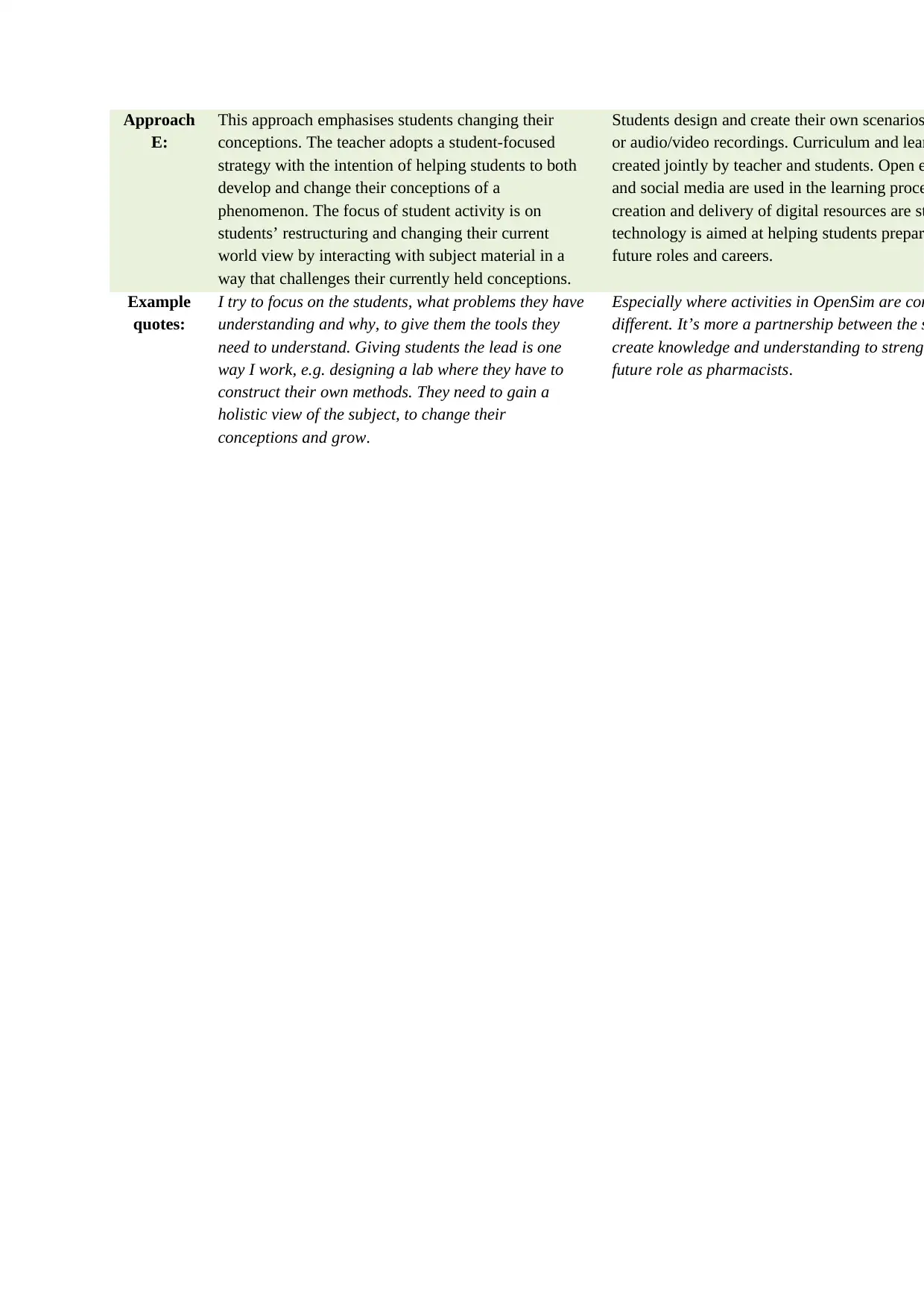
Approach
E:
This approach emphasises students changing their
conceptions. The teacher adopts a student-focused
strategy with the intention of helping students to both
develop and change their conceptions of a
phenomenon. The focus of student activity is on
students’ restructuring and changing their current
world view by interacting with subject material in a
way that challenges their currently held conceptions.
Students design and create their own scenarios
or audio/video recordings. Curriculum and lear
created jointly by teacher and students. Open e
and social media are used in the learning proce
creation and delivery of digital resources are st
technology is aimed at helping students prepar
future roles and careers.
Example
quotes:
I try to focus on the students, what problems they have
understanding and why, to give them the tools they
need to understand. Giving students the lead is one
way I work, e.g. designing a lab where they have to
construct their own methods. They need to gain a
holistic view of the subject, to change their
conceptions and grow.
Especially where activities in OpenSim are con
different. It’s more a partnership between the s
create knowledge and understanding to streng
future role as pharmacists.
E:
This approach emphasises students changing their
conceptions. The teacher adopts a student-focused
strategy with the intention of helping students to both
develop and change their conceptions of a
phenomenon. The focus of student activity is on
students’ restructuring and changing their current
world view by interacting with subject material in a
way that challenges their currently held conceptions.
Students design and create their own scenarios
or audio/video recordings. Curriculum and lear
created jointly by teacher and students. Open e
and social media are used in the learning proce
creation and delivery of digital resources are st
technology is aimed at helping students prepar
future roles and careers.
Example
quotes:
I try to focus on the students, what problems they have
understanding and why, to give them the tools they
need to understand. Giving students the lead is one
way I work, e.g. designing a lab where they have to
construct their own methods. They need to gain a
holistic view of the subject, to change their
conceptions and grow.
Especially where activities in OpenSim are con
different. It’s more a partnership between the s
create knowledge and understanding to streng
future role as pharmacists.
⊘ This is a preview!⊘
Do you want full access?
Subscribe today to unlock all pages.

Trusted by 1+ million students worldwide
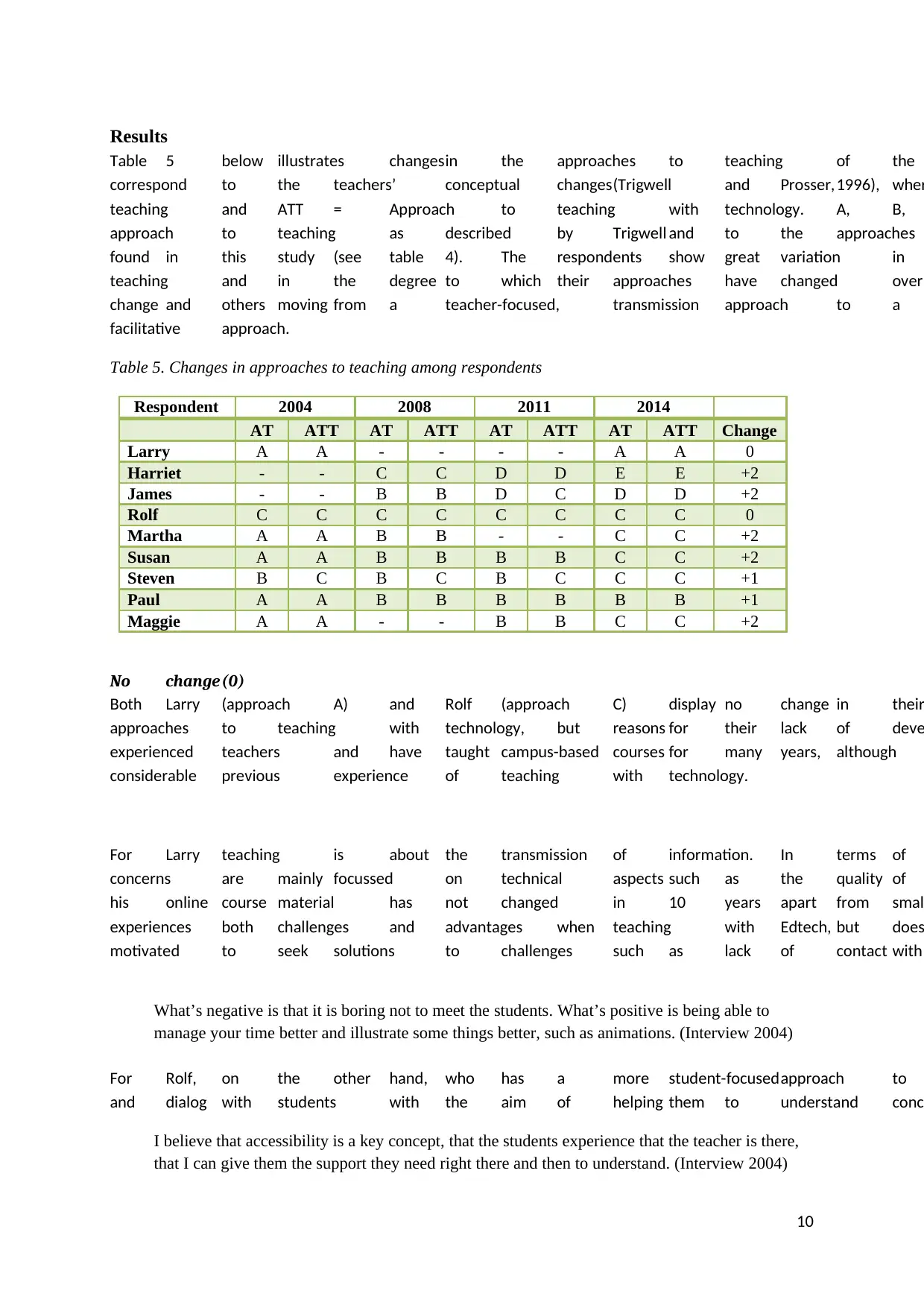
10
Results
Table 5 below illustrates changesin the approaches to teaching of the
correspond to the teachers’ conceptual changes(Trigwell and Prosser,1996), wher
teaching and ATT = Approach to teaching with technology. A, B,
approach to teaching as described by Trigwell and to the approaches
found in this study (see table 4). The respondents show great variation in
teaching and in the degree to which their approaches have changed over
change and others moving from a teacher-focused, transmission approach to a
facilitative approach.
Table 5. Changes in approaches to teaching among respondents
Respondent 2004 2008 2011 2014
AT ATT AT ATT AT ATT AT ATT Change
Larry A A - - - - A A 0
Harriet - - C C D D E E +2
James - - B B D C D D +2
Rolf C C C C C C C C 0
Martha A A B B - - C C +2
Susan A A B B B B C C +2
Steven B C B C B C C C +1
Paul A A B B B B B B +1
Maggie A A - - B B C C +2
No change(0)
Both Larry (approach A) and Rolf (approach C) display no change in their
approaches to teaching with technology, but reasons for their lack of deve
experienced teachers and have taught campus-based courses for many years, although
considerable previous experience of teaching with technology.
For Larry teaching is about the transmission of information. In terms of
concerns are mainly focussed on technical aspects such as the quality of
his online course material has not changed in 10 years apart from smal
experiences both challenges and advantages when teaching with Edtech, but does
motivated to seek solutions to challenges such as lack of contact with
What’s negative is that it is boring not to meet the students. What’s positive is being able to
manage your time better and illustrate some things better, such as animations. (Interview 2004)
For Rolf, on the other hand, who has a more student-focusedapproach to
and dialog with students with the aim of helping them to understand conc
I believe that accessibility is a key concept, that the students experience that the teacher is there,
that I can give them the support they need right there and then to understand. (Interview 2004)
Results
Table 5 below illustrates changesin the approaches to teaching of the
correspond to the teachers’ conceptual changes(Trigwell and Prosser,1996), wher
teaching and ATT = Approach to teaching with technology. A, B,
approach to teaching as described by Trigwell and to the approaches
found in this study (see table 4). The respondents show great variation in
teaching and in the degree to which their approaches have changed over
change and others moving from a teacher-focused, transmission approach to a
facilitative approach.
Table 5. Changes in approaches to teaching among respondents
Respondent 2004 2008 2011 2014
AT ATT AT ATT AT ATT AT ATT Change
Larry A A - - - - A A 0
Harriet - - C C D D E E +2
James - - B B D C D D +2
Rolf C C C C C C C C 0
Martha A A B B - - C C +2
Susan A A B B B B C C +2
Steven B C B C B C C C +1
Paul A A B B B B B B +1
Maggie A A - - B B C C +2
No change(0)
Both Larry (approach A) and Rolf (approach C) display no change in their
approaches to teaching with technology, but reasons for their lack of deve
experienced teachers and have taught campus-based courses for many years, although
considerable previous experience of teaching with technology.
For Larry teaching is about the transmission of information. In terms of
concerns are mainly focussed on technical aspects such as the quality of
his online course material has not changed in 10 years apart from smal
experiences both challenges and advantages when teaching with Edtech, but does
motivated to seek solutions to challenges such as lack of contact with
What’s negative is that it is boring not to meet the students. What’s positive is being able to
manage your time better and illustrate some things better, such as animations. (Interview 2004)
For Rolf, on the other hand, who has a more student-focusedapproach to
and dialog with students with the aim of helping them to understand conc
I believe that accessibility is a key concept, that the students experience that the teacher is there,
that I can give them the support they need right there and then to understand. (Interview 2004)
Paraphrase This Document
Need a fresh take? Get an instant paraphrase of this document with our AI Paraphraser
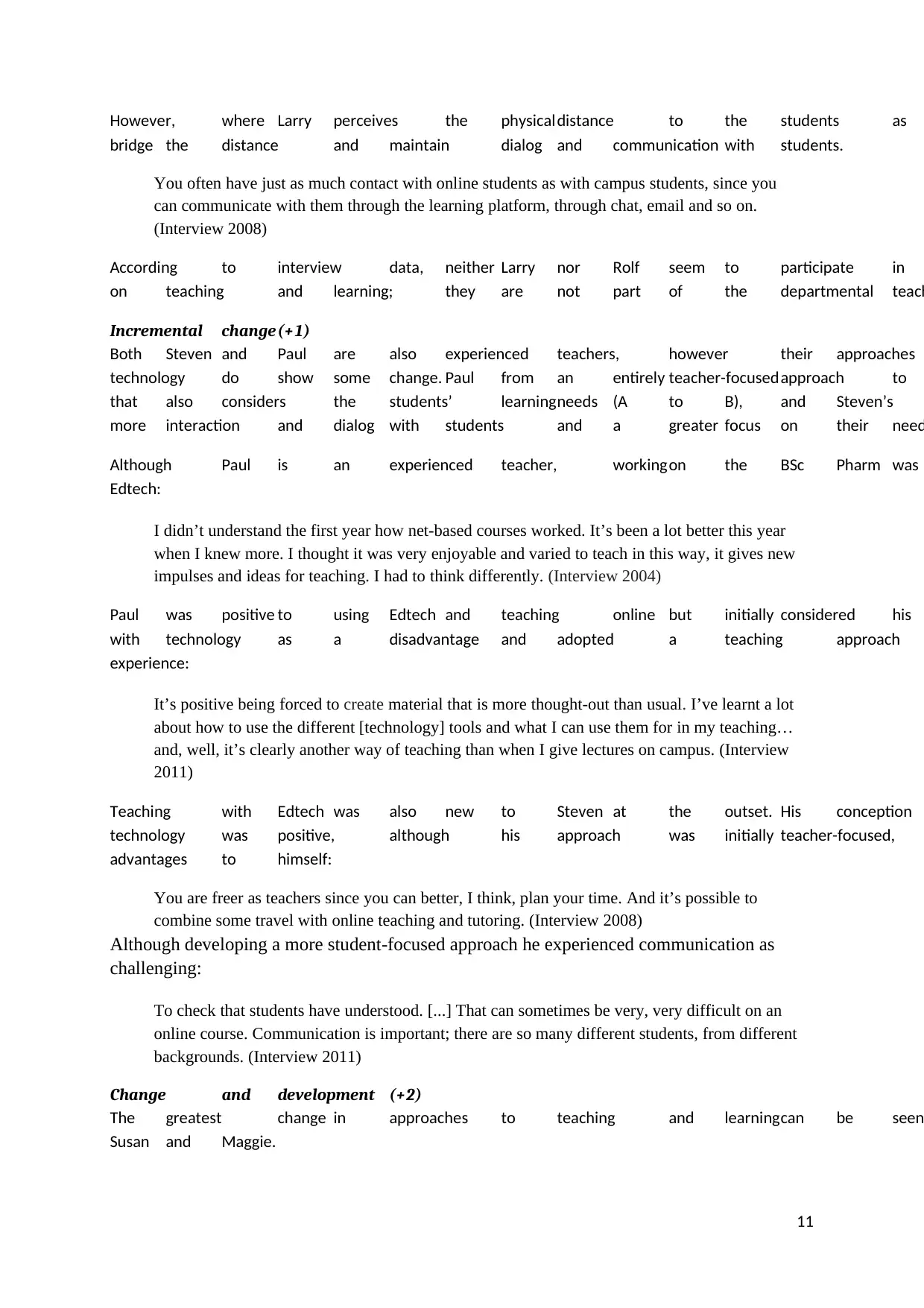
11
However, where Larry perceives the physicaldistance to the students as
bridge the distance and maintain dialog and communication with students.
You often have just as much contact with online students as with campus students, since you
can communicate with them through the learning platform, through chat, email and so on.
(Interview 2008)
According to interview data, neither Larry nor Rolf seem to participate in
on teaching and learning; they are not part of the departmental teach
Incremental change(+1)
Both Steven and Paul are also experienced teachers, however their approaches
technology do show some change. Paul from an entirely teacher-focusedapproach to
that also considers the students’ learningneeds (A to B), and Steven’s
more interaction and dialog with students and a greater focus on their need
Although Paul is an experienced teacher, workingon the BSc Pharm was
Edtech:
I didn’t understand the first year how net-based courses worked. It’s been a lot better this year
when I knew more. I thought it was very enjoyable and varied to teach in this way, it gives new
impulses and ideas for teaching. I had to think differently. (Interview 2004)
Paul was positive to using Edtech and teaching online but initially considered his
with technology as a disadvantage and adopted a teaching approach
experience:
It’s positive being forced to create material that is more thought-out than usual. I’ve learnt a lot
about how to use the different [technology] tools and what I can use them for in my teaching…
and, well, it’s clearly another way of teaching than when I give lectures on campus. (Interview
2011)
Teaching with Edtech was also new to Steven at the outset. His conception
technology was positive, although his approach was initially teacher-focused,
advantages to himself:
You are freer as teachers since you can better, I think, plan your time. And it’s possible to
combine some travel with online teaching and tutoring. (Interview 2008)
Although developing a more student-focused approach he experienced communication as
challenging:
To check that students have understood. [...] That can sometimes be very, very difficult on an
online course. Communication is important; there are so many different students, from different
backgrounds. (Interview 2011)
Change and development (+2)
The greatest change in approaches to teaching and learningcan be seen
Susan and Maggie.
However, where Larry perceives the physicaldistance to the students as
bridge the distance and maintain dialog and communication with students.
You often have just as much contact with online students as with campus students, since you
can communicate with them through the learning platform, through chat, email and so on.
(Interview 2008)
According to interview data, neither Larry nor Rolf seem to participate in
on teaching and learning; they are not part of the departmental teach
Incremental change(+1)
Both Steven and Paul are also experienced teachers, however their approaches
technology do show some change. Paul from an entirely teacher-focusedapproach to
that also considers the students’ learningneeds (A to B), and Steven’s
more interaction and dialog with students and a greater focus on their need
Although Paul is an experienced teacher, workingon the BSc Pharm was
Edtech:
I didn’t understand the first year how net-based courses worked. It’s been a lot better this year
when I knew more. I thought it was very enjoyable and varied to teach in this way, it gives new
impulses and ideas for teaching. I had to think differently. (Interview 2004)
Paul was positive to using Edtech and teaching online but initially considered his
with technology as a disadvantage and adopted a teaching approach
experience:
It’s positive being forced to create material that is more thought-out than usual. I’ve learnt a lot
about how to use the different [technology] tools and what I can use them for in my teaching…
and, well, it’s clearly another way of teaching than when I give lectures on campus. (Interview
2011)
Teaching with Edtech was also new to Steven at the outset. His conception
technology was positive, although his approach was initially teacher-focused,
advantages to himself:
You are freer as teachers since you can better, I think, plan your time. And it’s possible to
combine some travel with online teaching and tutoring. (Interview 2008)
Although developing a more student-focused approach he experienced communication as
challenging:
To check that students have understood. [...] That can sometimes be very, very difficult on an
online course. Communication is important; there are so many different students, from different
backgrounds. (Interview 2011)
Change and development (+2)
The greatest change in approaches to teaching and learningcan be seen
Susan and Maggie.
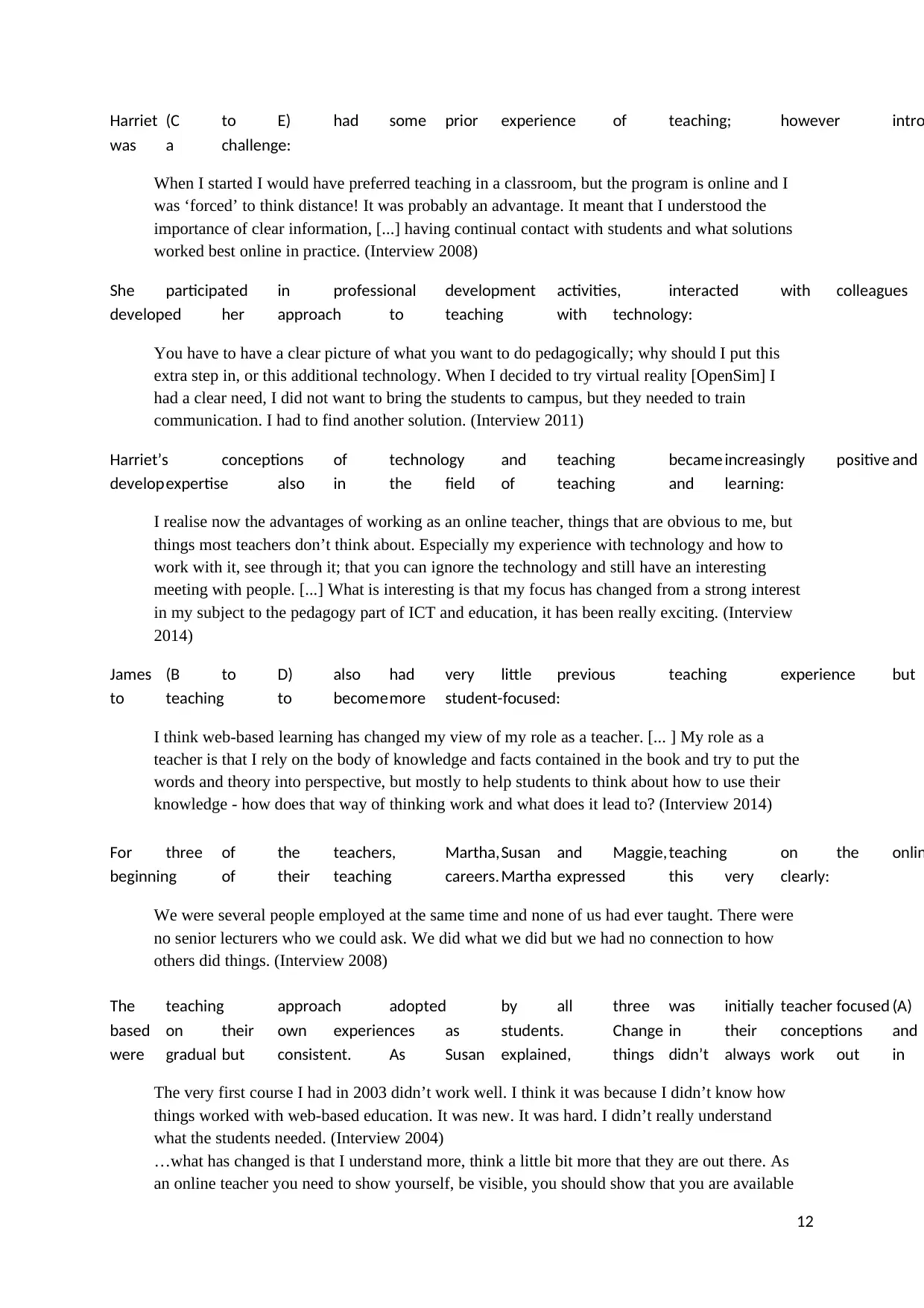
12
Harriet (C to E) had some prior experience of teaching; however intro
was a challenge:
When I started I would have preferred teaching in a classroom, but the program is online and I
was ‘forced’ to think distance! It was probably an advantage. It meant that I understood the
importance of clear information, [...] having continual contact with students and what solutions
worked best online in practice. (Interview 2008)
She participated in professional development activities, interacted with colleagues
developed her approach to teaching with technology:
You have to have a clear picture of what you want to do pedagogically; why should I put this
extra step in, or this additional technology. When I decided to try virtual reality [OpenSim] I
had a clear need, I did not want to bring the students to campus, but they needed to train
communication. I had to find another solution. (Interview 2011)
Harriet’s conceptions of technology and teaching became increasingly positive and
developexpertise also in the field of teaching and learning:
I realise now the advantages of working as an online teacher, things that are obvious to me, but
things most teachers don’t think about. Especially my experience with technology and how to
work with it, see through it; that you can ignore the technology and still have an interesting
meeting with people. [...] What is interesting is that my focus has changed from a strong interest
in my subject to the pedagogy part of ICT and education, it has been really exciting. (Interview
2014)
James (B to D) also had very little previous teaching experience but
to teaching to becomemore student-focused:
I think web-based learning has changed my view of my role as a teacher. [... ] My role as a
teacher is that I rely on the body of knowledge and facts contained in the book and try to put the
words and theory into perspective, but mostly to help students to think about how to use their
knowledge - how does that way of thinking work and what does it lead to? (Interview 2014)
For three of the teachers, Martha,Susan and Maggie,teaching on the onlin
beginning of their teaching careers. Martha expressed this very clearly:
We were several people employed at the same time and none of us had ever taught. There were
no senior lecturers who we could ask. We did what we did but we had no connection to how
others did things. (Interview 2008)
The teaching approach adopted by all three was initially teacher focused (A)
based on their own experiences as students. Change in their conceptions and
were gradual but consistent. As Susan explained, things didn’t always work out in
The very first course I had in 2003 didn’t work well. I think it was because I didn’t know how
things worked with web-based education. It was new. It was hard. I didn’t really understand
what the students needed. (Interview 2004)
…what has changed is that I understand more, think a little bit more that they are out there. As
an online teacher you need to show yourself, be visible, you should show that you are available
Harriet (C to E) had some prior experience of teaching; however intro
was a challenge:
When I started I would have preferred teaching in a classroom, but the program is online and I
was ‘forced’ to think distance! It was probably an advantage. It meant that I understood the
importance of clear information, [...] having continual contact with students and what solutions
worked best online in practice. (Interview 2008)
She participated in professional development activities, interacted with colleagues
developed her approach to teaching with technology:
You have to have a clear picture of what you want to do pedagogically; why should I put this
extra step in, or this additional technology. When I decided to try virtual reality [OpenSim] I
had a clear need, I did not want to bring the students to campus, but they needed to train
communication. I had to find another solution. (Interview 2011)
Harriet’s conceptions of technology and teaching became increasingly positive and
developexpertise also in the field of teaching and learning:
I realise now the advantages of working as an online teacher, things that are obvious to me, but
things most teachers don’t think about. Especially my experience with technology and how to
work with it, see through it; that you can ignore the technology and still have an interesting
meeting with people. [...] What is interesting is that my focus has changed from a strong interest
in my subject to the pedagogy part of ICT and education, it has been really exciting. (Interview
2014)
James (B to D) also had very little previous teaching experience but
to teaching to becomemore student-focused:
I think web-based learning has changed my view of my role as a teacher. [... ] My role as a
teacher is that I rely on the body of knowledge and facts contained in the book and try to put the
words and theory into perspective, but mostly to help students to think about how to use their
knowledge - how does that way of thinking work and what does it lead to? (Interview 2014)
For three of the teachers, Martha,Susan and Maggie,teaching on the onlin
beginning of their teaching careers. Martha expressed this very clearly:
We were several people employed at the same time and none of us had ever taught. There were
no senior lecturers who we could ask. We did what we did but we had no connection to how
others did things. (Interview 2008)
The teaching approach adopted by all three was initially teacher focused (A)
based on their own experiences as students. Change in their conceptions and
were gradual but consistent. As Susan explained, things didn’t always work out in
The very first course I had in 2003 didn’t work well. I think it was because I didn’t know how
things worked with web-based education. It was new. It was hard. I didn’t really understand
what the students needed. (Interview 2004)
…what has changed is that I understand more, think a little bit more that they are out there. As
an online teacher you need to show yourself, be visible, you should show that you are available
⊘ This is a preview!⊘
Do you want full access?
Subscribe today to unlock all pages.

Trusted by 1+ million students worldwide
1 out of 18